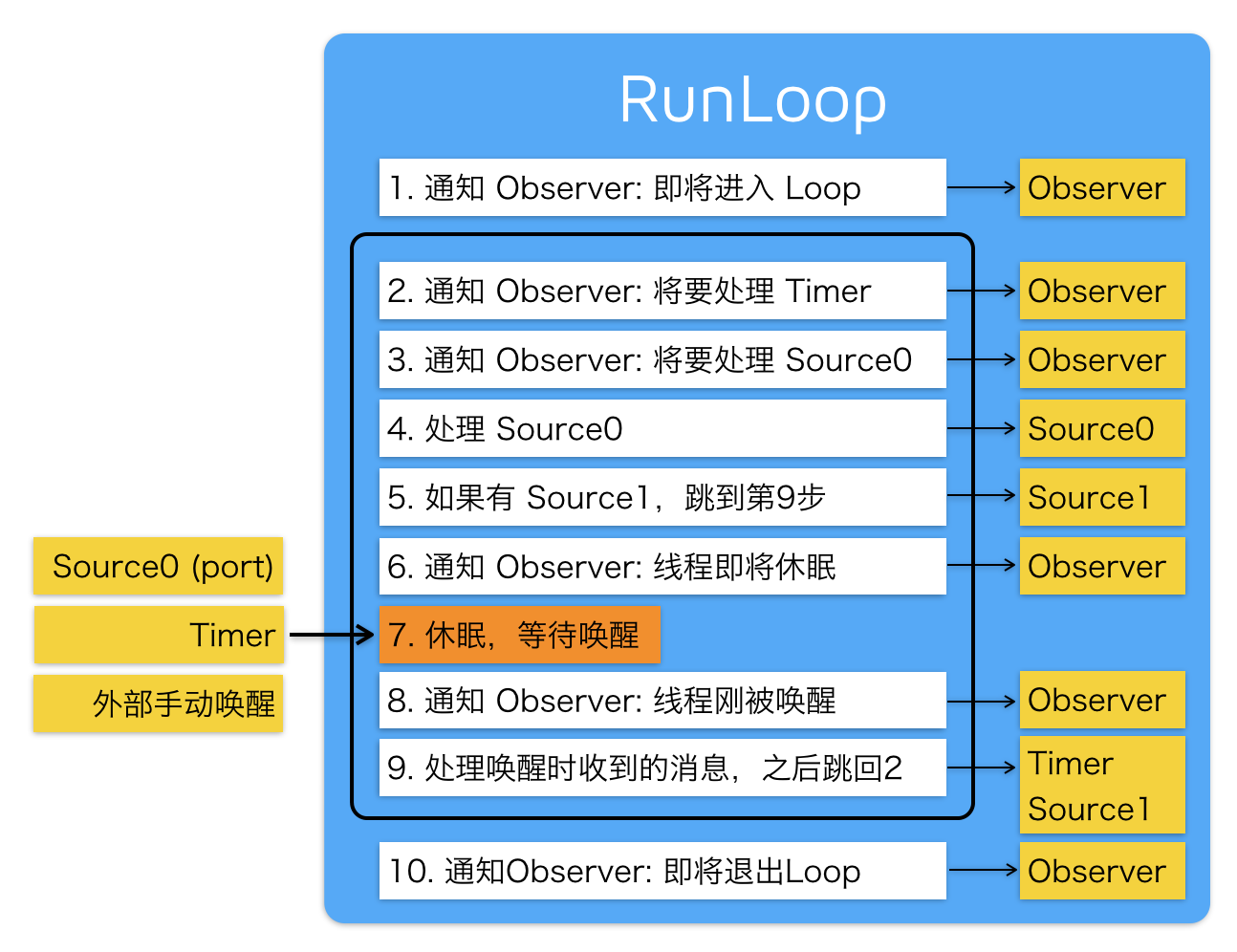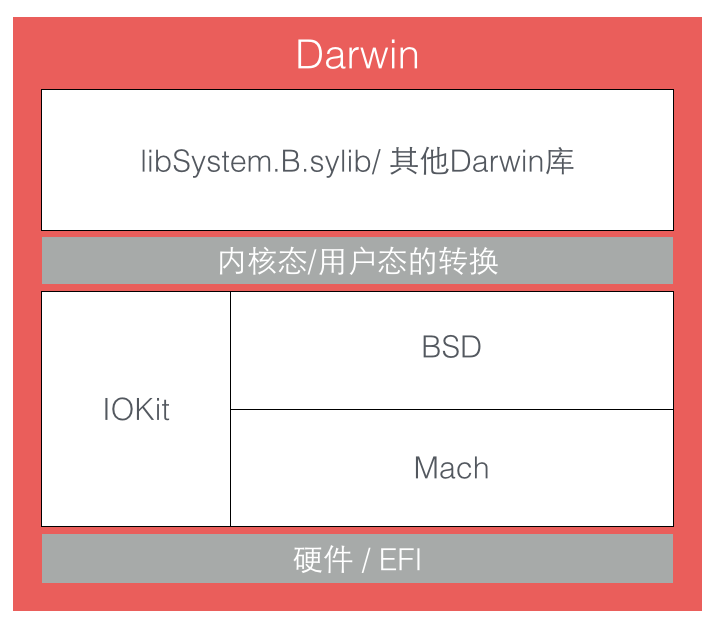RunLoop 的内部逻辑
根据苹果在文档里的说明,RunLoop 内部的逻辑大致如下:

内部代码整理为:
1 2 3 4 5 6 7 8 9 10 11 12 13 14 15 16 17 18 19 20 21 22 23 24 25 26 27 28 29 30 31 32 33 34 35 36 37 38 39 40 41 42 43 44 45 46 47 48 49 50 51 52 53 54 55 56 57 58 59 60 61 62 63 64 65 66 67 68 69 70 71 72 73 74 75 76 77 78 79 80 81 82 83 84 85 86 87 88 89 90 91 92 93 94 95 96 97 98 99 100 101 102 103 104 105 106 107 108 109 110 | |
可以看到,实际上 RunLoop 就是这样一个函数,其内部是一个 do-while 循环。当你调用 CFRunLoopRun() 时,线程就会一直停留在这个循环里;直到超时或被手动停止,该函数才会返回
RunLoop 的底层实现
从上面代码可以看到,RunLoop 的核心是基于 mach port 的,其进入休眠时调用的函数是 mach_msg()。为了解释这个逻辑,下面稍微介绍一下 OSX/iOS 的系统架构。

苹果官方将整个系统大致划分为上述4个层次: 应用层包括用户能接触到的图形应用,例如 Spotlight、Aqua、SpringBoard 等。 应用框架层即开发人员接触到的 Cocoa 等框架。 核心框架层包括各种核心框架、OpenGL 等内容。 Darwin 即操作系统的核心,包括系统内核、驱动、Shell 等内容,这一层是开源的,其所有源码都可以在 opensource.apple.com 里找到。
我们在深入看一下 Darwin 这个核心的架构
 其中,在硬件层上面的三个组成部分:Mach、BSD、IOKit (还包括一些上面没标注的内容),共同组成了 XNU 内核。
XNU 内核的内环被称作 Mach,其作为一个微内核,仅提供了诸如处理器调度、IPC (进程间通信)等非常少量的基础服务。
BSD 层可以看作围绕 Mach 层的一个外环,其提供了诸如进程管理、文件系统和网络等功能。
IOKit 层是为设备驱动提供了一个面向对象(C++)的一个框架。
其中,在硬件层上面的三个组成部分:Mach、BSD、IOKit (还包括一些上面没标注的内容),共同组成了 XNU 内核。
XNU 内核的内环被称作 Mach,其作为一个微内核,仅提供了诸如处理器调度、IPC (进程间通信)等非常少量的基础服务。
BSD 层可以看作围绕 Mach 层的一个外环,其提供了诸如进程管理、文件系统和网络等功能。
IOKit 层是为设备驱动提供了一个面向对象(C++)的一个框架。
Mach 本身提供的 API 非常有限,而且苹果也不鼓励使用 Mach 的 API,但是这些API非常基础,如果没有这些API的话,其他任何工作都无法实施。在 Mach 中,所有的东西都是通过自己的对象实现的,进程、线程和虚拟内存都被称为"对象"。和其他架构不同, Mach 的对象间不能直接调用,只能通过消息传递的方式实现对象间的通信。"消息"是 Mach 中最基础的概念,消息在两个端口 (port) 之间传递,这就是 Mach 的 IPC (进程间通信) 的核心。
Mach 的消息定义是在 <mach/message.h> 头文件的,很简单:
1 2 3 4 5 6 7 8 9 10 11 12 13 | |
一条 Mach 消息实际上就是一个二进制数据包 (BLOB),其头部定义了当前端口 local_port 和目标端口 remote_port, 发送和接受消息是通过同一个 API 进行的,其 option 标记了消息传递的方向:
1 2 3 4 5 6 7 8 | |
为了实现消息的发送和接收,mach_msg() 函数实际上是调用了一个 Mach 陷阱 (trap),即函数mach_msg_trap(),陷阱这个概念在 Mach 中等同于系统调用。当你在用户态调用 mach_msg_trap() 时会触发陷阱机制,切换到内核态;内核态中内核实现的 mach_msg() 函数会完成实际的工作,如下图:
 这些概念可以参考维基百科:System_call、Trap_(computing))
这些概念可以参考维基百科:System_call、Trap_(computing))
RunLoop 的核心就是一个 mach_msg() (见上面代码的第7步),RunLoop 调用这个函数去接收消息,如果没有别人发送 port 消息过来,内核会将线程置于等待状态。例如你在模拟器里跑起一个 iOS 的 App,然后在 App 静止时点击暂停,你会看到主线程调用栈是停留在 mach_msg_trap() 这个地方。
关于具体的如何利用 mach port 发送信息,可以看看 NSHipster 这一篇文章,或者这里的中文翻译 。
关于Mach的历史可以看看这篇很有趣的文章:Mac OS X 背后的故事(三)Mach 之父 Avie Tevanian。
特别致谢:
http://blog.ibireme.com/ 2015/05/18/runloop/#more-41710
参考文章:
深入理解RunLoop(ibireme):
http://blog.ibireme.com/ 2015/05/18/runloop/#more-41710
Apple Document: https://developer.apple.com/library/ios/documentation/Cocoa/Conceptual/Multithreading/RunLoopManagement/RunLoopManagement.html
维基百科:
System_call、 Trap_(computing))
NSHipster: